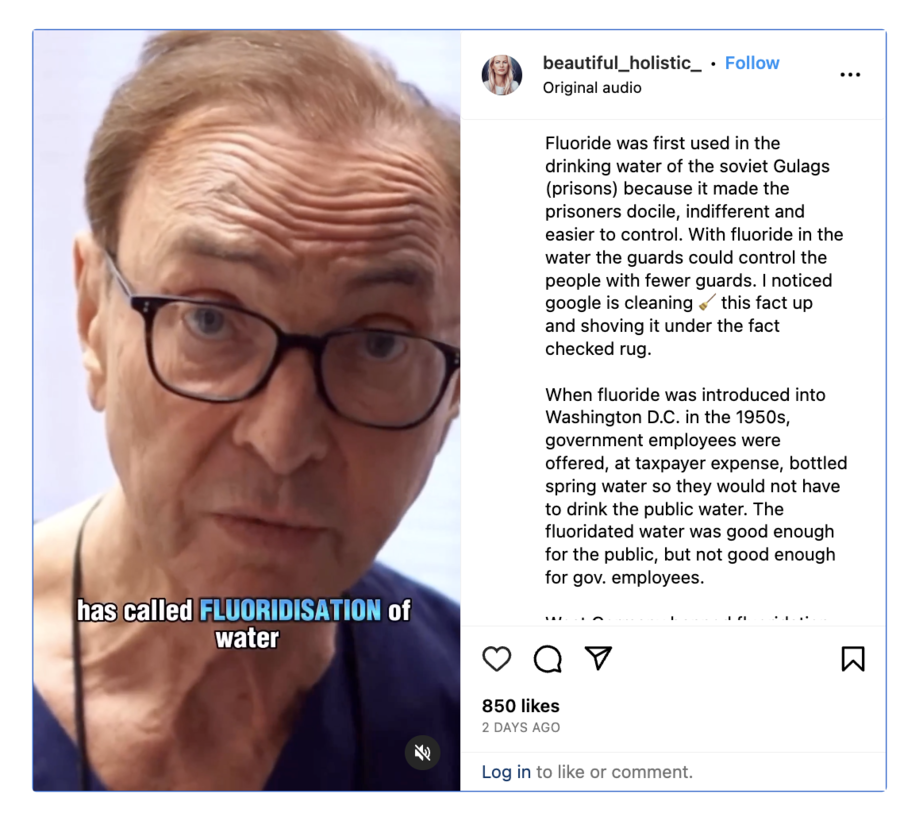
Did the Soviet Union pioneer water fluoridation? Did it use it on prisoners in the Gulag system to control them? No, that's not true: The United States was the first country in the world to implement this technology, and there is no indication that the Soviet Union had the capability of ensuring the delivery of fluoridated drinking water to all facilities inside its widespread forced-labor system.
The claim appeared in a post on Instagram on June 5, 2023. The lengthy caption said, in part:
Fluoride was first used in the drinking water of the soviet Gulags (prisons) because it made the prisoners docile, indifferent and easier to control. With fluoride in the water the guards could control the people with fewer guards. I noticed google is cleaning 🧹 this fact up and shoving it under the fact checked rug.
Here is what it looked like at the time of writing:
(Source: Instagram screenshot taken on Thu Jun 8 18:32.22 2023 UTC)
Contrary to the claim, the first known instance of man-produced water fluoridation took place in Grand Rapids, Michigan, in 1945, not in the USSR. According to the National Institute of Dental and Craniofacial Research, after monitoring 30,000 children of school age for 15 years, scientists discovered that the rate of tooth decay dropped by 60 percent with fluoride.
Prior to it, researchers only observed the areas with naturally occurring low or high levels of fluoride in drinking water.
The Soviet Union lagged behind. While its dentists did look into anti-caries (caries, also known as tooth decay or cavities, is the most common noncommunicable disease worldwide, according to the World Health Organization) properties of fluoride in the late 1930s, their approach was largely focused on the local application of the element to the teeth. Up until the late 1950s, Soviet academic articles heavily relied on American sources on water fluoridation (for example, here and here.)
The Soviet Ministry of Health approved temporary standards for water fluoridation only in 1958, five years after Premier Joseph Stalin's death. In 1960, Norilsk became the first Soviet city where the new technology was implemented.
The further construction of the water fluoridation stations was rather slow and unsuccessful, as described by a 2012 Russian-language paper (translated from Russian by Lead Stories):
It was not until July 21, 1972, that the Council of Ministers of the USSR adopted a resolution 'On the construction of water fluoridation units in all major cities of the country.' Fluoridation units were installed in 140 cities, but their technical parameters did not meet technical requirements. When they were used for a long time, the quality of raw materials did not always meet technical norms, so the plants actually worked only in 10 cities. Great resistance was offered by public utility services tasked with the fluoridation of water. They thought of this important preventive measure as an additional load [of work] for themselves and found various reasons to refuse it, referring to the fact that fluorine compounds allegedly caused corrosion of pipes.
Shortly before the USSR's fall, American dentist Richard Abrams had water samples from two major Russian cities tested in independent laboratories. Here is how the 1988 Washington Post article described the results:
For years, red-baiters said water fluoridation was a communist plot, aimed at pacifying the masses.Now that argument may have a huge cavity. It seems the Russians don't even fluoridate their own water.Those were the results anyhow from samples of water spirited out of Moscow and Leningrad between 1983 and 1986. Out of 47 samples, all but three had fluoride levels below 0.8 parts per million, the threshold for providing an anti-cavity effect.
The Soviet Gulag was not a single prison with a single source of centralized water supply -- it was a vast system spread across 12 time zones. It included forced-labor camps, colonies and even research institutes where imprisoned scientists worked on government-assigned projects typically aimed at increasing the military capabilities of the state. It would be an impossible task to deliver fluoridated drinking water through a single centralized supply to all the facilities while simultaneously excluding guards and civil populations of nearby towns and villages.
The Gulag system was plagued with fast-spreading diseases as a result of overcrowded living conditions, a lack of nutritious food and poor sanitary conditions. Access to clean drinking water was a major problem, too: at times, prisoners didn't receive any of it at all and had to consume any water they could find, which contributed to outbreaks of dysentery.
A rare work describing the organization of sanitary service in the Gulag system written by B. Nakhapetov explicitly mentions that many hired Gulag employees didn't have access to good-quality drinking water, either:
Everything is squalid, roadless, horrible supply, no entertainment, except to get drunk [...] All that an employee and his family have seen for years is a zone. For example, in Perm colony - the place is low-lying and swampy, the water is disgusting, and in the settlement is worse than in the zone.
(Translated by DeepL.)
Despite inhumane conditions, harsh forced labor, a lack of basic necessities and widespread practices of dehumanization aimed at breaking prisoners' spirits, the assumption that people incarcerated in the Gulag system were an overwhelmingly "docile" mass is far-fetched. Acts of rebellion took place even there, including three major uprisings. Some resorted to self-inflicted wounds to avoid dangerous work, and pretending that the assigned tasks were completed -- a phenomenon collectively known as tufta -- was a routinely used strategy both inside and outside the Soviet prison complex.
Some Soviet prisoners prepared a substance called chifir, which was black tea boiled a long time. Black tea is one of the foods containing high levels of naturally occurring fluoride, but prisoners were not forced to consume it -- it was rather considered a prohibited activity incarcerated people would do at their own risk in anticipation of experiencing the caffeine-related stimulating effect of the drink.
The Gulag system did include some medical research. However, stripped of equipment and resources, medical personnel, often prisoners themselves, frequently only documented the effects of harsh conditions on the prisoners, omitting its causes, as declassified documents indicate.
Between the late 1930s and Stalin's death, the Soviet government also ran medical experiments on humans with the purpose of inventing a poison without any smell or taste that wouldn't be detected in the body posthumously. The victims were prisoners; the project was run by the NKVD, the Soviet interior police that was additionally in charge of the prison complex oversight. But credible Russian sources (for example, here and here) do not mention highly toxic fluorine (which has very different chemical properties) being part of those deadly experiments. As of 2010, many documents detailing the list of used substances and the names of the victims remained classified. In 2023, there is no indication that the Russian government has released that information.
Fluoride used in drinking water is safe in small amounts, and it should be distinguished from fluorine. Many related claims conflate the two. Fluorine, not fluoride, is included in the formula of Novichok, a notorious nerve agent used by contemporary Russia to poison its political opponents. But most researchers place its invention in the 1970s, decades after Stalin's death.
Other Lead Stories fact checks about fluoride can be found here.













